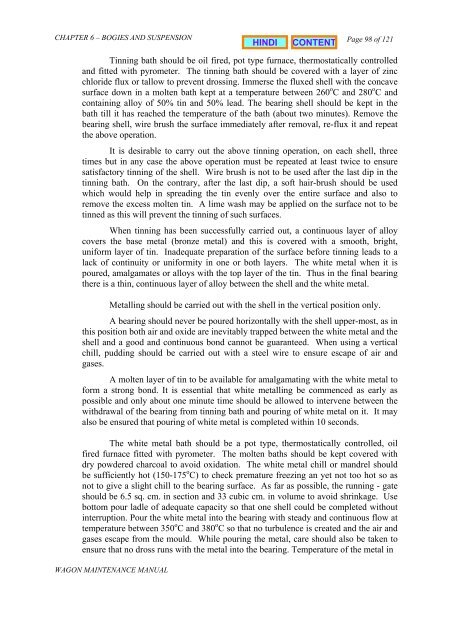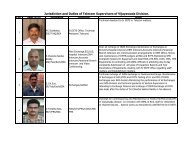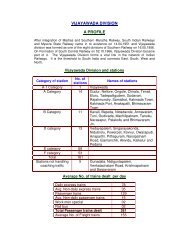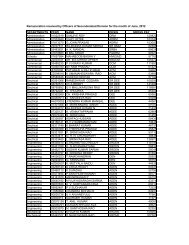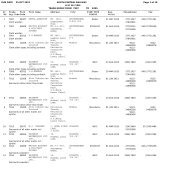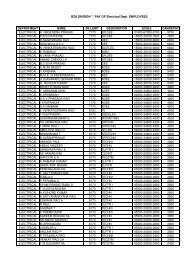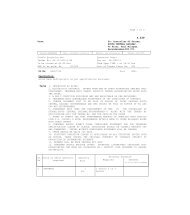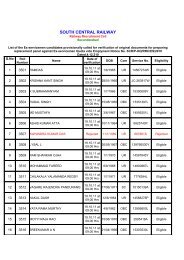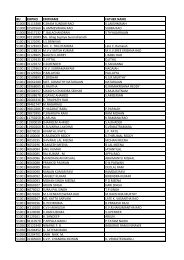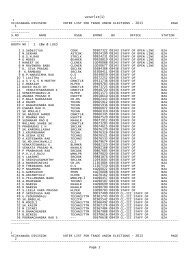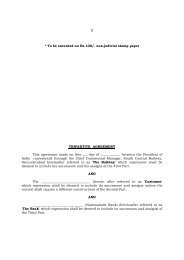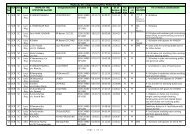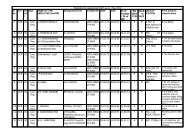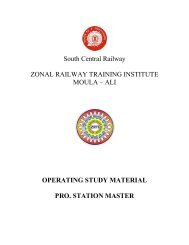BOGIES AND SUSPENSION - South Central Railway
BOGIES AND SUSPENSION - South Central Railway
BOGIES AND SUSPENSION - South Central Railway
You also want an ePaper? Increase the reach of your titles
YUMPU automatically turns print PDFs into web optimized ePapers that Google loves.
CHAPTER 6 – <strong>BOGIES</strong> <strong>AND</strong> <strong>SUSPENSION</strong><br />
WAGON MAINTENANCE MANUAL<br />
Page 98 of 121<br />
Tinning bath should be oil fired, pot type furnace, thermostatically controlled<br />
and fitted with pyrometer. The tinning bath should be covered with a layer of zinc<br />
chloride flux or tallow to prevent drossing. Immerse the fluxed shell with the concave<br />
surface down in a molten bath kept at a temperature between 260 o C and 280 o C and<br />
containing alloy of 50% tin and 50% lead. The bearing shell should be kept in the<br />
bath till it has reached the temperature of the bath (about two minutes). Remove the<br />
bearing shell, wire brush the surface immediately after removal, re-flux it and repeat<br />
the above operation.<br />
It is desirable to carry out the above tinning operation, on each shell, three<br />
times but in any case the above operation must be repeated at least twice to ensure<br />
satisfactory tinning of the shell. Wire brush is not to be used after the last dip in the<br />
tinning bath. On the contrary, after the last dip, a soft hair-brush should be used<br />
which would help in spreading the tin evenly over the entire surface and also to<br />
remove the excess molten tin. A lime wash may be applied on the surface not to be<br />
tinned as this will prevent the tinning of such surfaces.<br />
When tinning has been successfully carried out, a continuous layer of alloy<br />
covers the base metal (bronze metal) and this is covered with a smooth, bright,<br />
uniform layer of tin. Inadequate preparation of the surface before tinning leads to a<br />
lack of continuity or uniformity in one or both layers. The white metal when it is<br />
poured, amalgamates or alloys with the top layer of the tin. Thus in the final bearing<br />
there is a thin, continuous layer of alloy between the shell and the white metal.<br />
Metalling should be carried out with the shell in the vertical position only.<br />
A bearing should never be poured horizontally with the shell upper-most, as in<br />
this position both air and oxide are inevitably trapped between the white metal and the<br />
shell and a good and continuous bond cannot be guaranteed. When using a vertical<br />
chill, pudding should be carried out with a steel wire to ensure escape of air and<br />
gases.<br />
A molten layer of tin to be available for amalgamating with the white metal to<br />
form a strong bond. It is essential that white metalling be commenced as early as<br />
possible and only about one minute time should be allowed to intervene between the<br />
withdrawal of the bearing from tinning bath and pouring of white metal on it. It may<br />
also be ensured that pouring of white metal is completed within 10 seconds.<br />
The white metal bath should be a pot type, thermostatically controlled, oil<br />
fired furnace fitted with pyrometer. The molten baths should be kept covered with<br />
dry powdered charcoal to avoid oxidation. The white metal chill or mandrel should<br />
be sufficiently hot (150-175 o C) to check premature freezing an yet not too hot so as<br />
not to give a slight chill to the bearing surface. As far as possible, the running - gate<br />
should be 6.5 sq. cm. in section and 33 cubic cm. in volume to avoid shrinkage. Use<br />
bottom pour ladle of adequate capacity so that one shell could be completed without<br />
interruption. Pour the white metal into the bearing with steady and continuous flow at<br />
temperature between 350 o C and 380 o C so that no turbulence is created and the air and<br />
gases escape from the mould. While pouring the metal, care should also be taken to<br />
ensure that no dross runs with the metal into the bearing. Temperature of the metal in


